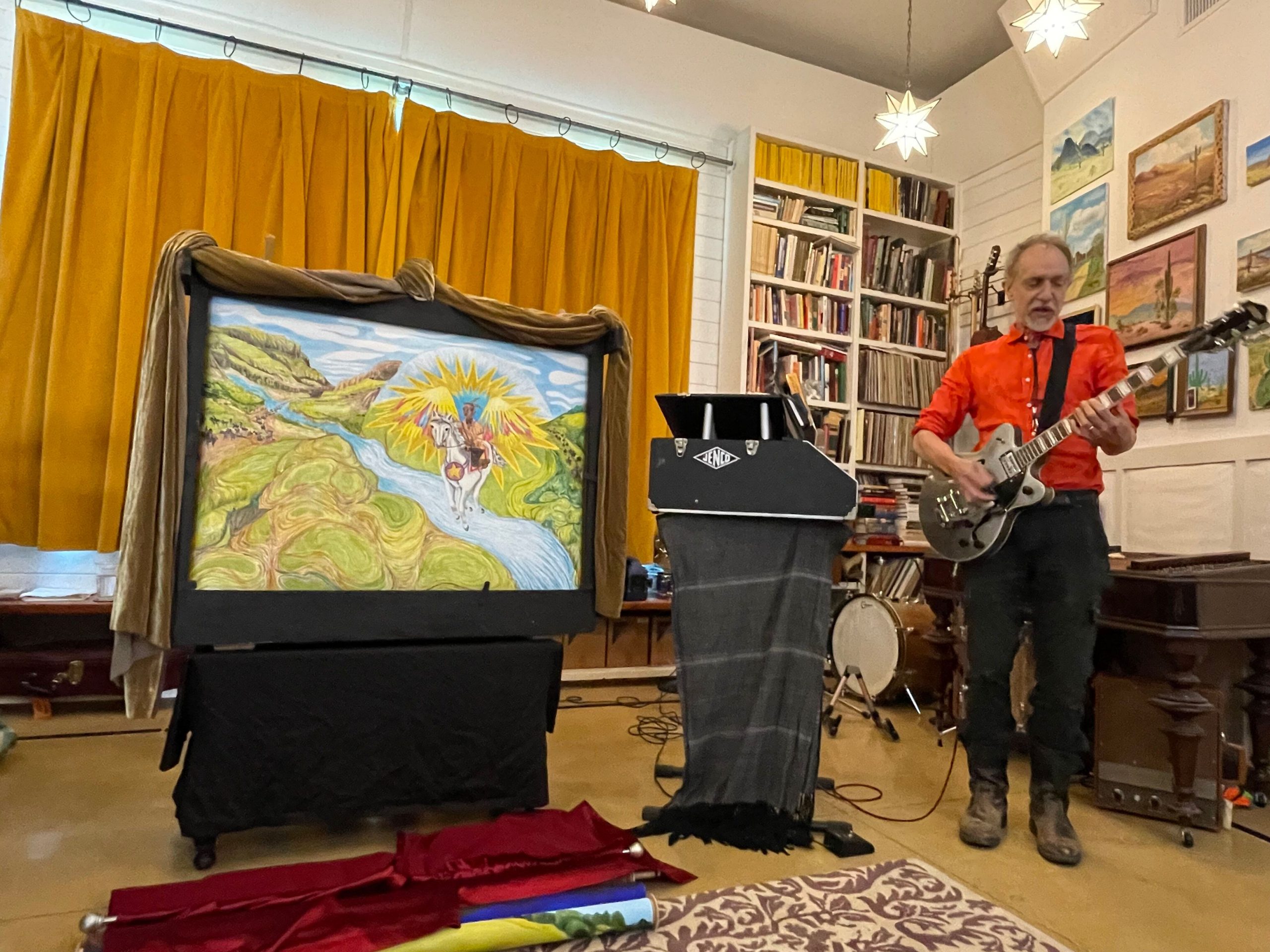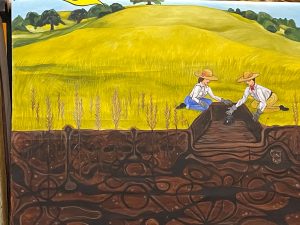
Images unroll on the crankie and accompany the music performed by Brian Beattie, creator of ‘El Camino Real de los Tejas Crankie Suite.’ Photo by Joe Nick Patoski.
There are two great stories of Texas, as far as Brian Beattie is concerned. One is the Alamo, about which much has been written, honored, preserved, and mythologized. The other, El Camino Real de las Tejas, not so much.
The historic King’s Highway linking northern Mexico with far East Texas is “our most underappreciated cultural resource,” Beattie says. “I don’t think there’s any single thing that sums up the story of Texas like El Camino. Everyone used this [highway]: the first humans, tribal traders, the animals who carved out a path before them. It wasn’t a battle [like the Alamo]; it was who we are. Everyone had to use it—natives, Spanish, Anglo settlers.”
An avid explorer of historical sites across Texas and a founding member of Glass Eye, an influential art rock group in 1980s Austin, Beattie set out to address El Camino’s lack of recognition by doing something that only a musician could do: He wrote a musical about it.
El Camino Real de los Tejas Crankie Suite, as the title implies, tells the story of Texas’ most historic road through Beattie’s vocals and electric guitar, accompanied occasionally by Mister Rogers’ Neighborhood-style plinks on a celesta keyboard. Helping tell the story is Beattie’s wife, visual artist Valerie Fowler, who, at the beginning of the show, pulls back the diminutive red curtains of a stage box about the size of a puppet show. Slowly, she starts turning one of two cranks on the top of the set, and moving images of different scenes she has painted appear in synch with Beattie’s storytelling.
That’s the “crankie” part of the musical’s title.
Used to create a scrolling panorama—or moving picture—the crankie was a means of enhanced storytelling predating cinema. It was one of the most popular forms of entertainment in the United States and England throughout the 1800s. Some crankies were bigger than a movie screen and toured theaters as exhibitions. The concept was revived in the late 20th century, largely by musicians, and thrives as a steampunk retro-futuristic artifact. Now, the device helps bring the Camino Real to audiences.
Beattie’s interest in the Camino Real started about seven years ago, when he attended an event at Lobanillo Swales in Sabine County. Tom Byrd, who was then president of the El Camino Real de los Tejas National Historic Trail Association, the official nonprofit partner of the National Park Service in the protection and development of the Camino Real across Texas and Louisiana, told him someone needs to write a song about the Camino like “Route 66.”
Beattie responded by writing a musical. “I realized at a certain point I wasn’t going to be the rock guy playing clubs, trying to do the thing that most younger people do,” he says. “I craved the narrative in songs, and I was too old to go out and pretend I was a rock dude.”

Visual artist Valerie Fowler created the images used in the crankie. Photo by Joe Nick Patoski.
Instead, Beattie became a history dude. He started reading books about the trail, and of all the resources he tapped into, he found the diaries from the first Spanish expeditions across Texas the most revealing, with descriptions of specific tribes and their movements, alliances, and customs.
But the fire for the project was really lit when Beattie took a long bicycle ride and stumbled upon ruins at a site of a future park southeast of Austin. In his research, he came upon a passage that mentioned a particular entrada, or trail entrance, and a spring and a creek. He realized what he’d seen while cycling had been described by Spanish explorers.
“Everyone agrees with this description,” he says. “They camped around this creek that had no name. Exactly 2.65 miles southwest of McKinney Falls today is Onion Creek Metropolitan Park, 450 acres that are unanalyzed. That’s where I’ve found big beautiful swales and four homestead sites. There’s stuff no one knows about and you can learn about [it] just walking around.”
As for the crankie, this is not the first time Beattie has incorporated one into a show. He used one in his 2014 musical, Ivy and the Wicker Suitcase, an ambitious project that included his former bandmate Kathy McCarty, composer Will Sheff of Okkervil River, singer Grace London, guitarist Bill Callahan, and the late savant Daniel Johnston.
For the Crankie Suite, Fowler spent a year drawing and painting fluid, impressionistic landscapes peppered with historic figures on two 48-foot-by-30-inch rolls of paper. First, she penciled in the images, then applied ink, a lot of watercolor, and colored pencils. “It’s multimedia,” she says, adding it’s also all Brian. “He told me what to draw, which scene, measured it out how it would go with the timing of the songs. And I just drew it.”
At each performance, Beattie introduces the crankie. “It’s kind of like a time machine, but it’s hand-cranked,” he says in a showman’s voice. “It becomes our window into history during our curious journey across Texas. Please do not climb into the crankie box!”
He then explains that the expedition “will go by in a flash,” taking the audience from Mission San Juan Bautista in Guerrero, Coahuila, through what is now Laredo, to Los Adaes, Louisiana [the capital of New Spain]. Along the way, he says, “We will be bouncing through time meeting different people in a manner which may be disorienting…Just remember, although every stop on our tour is a different place at a different time, we’re simply traveling northeast.”
With Beattie’s dramatic singing, fuzzy guitar chunks on his Gretsch, and Fowler’s illustrations, it’s a compelling 45-minute saga. The narrative song artfully explains, in rhyme, how the King of Spain ordered six Spanish missions and a fort established along the route. The goal was preventing the French from encroaching on New Spain. Once Los Adaes was declared capital of the province of Texas, it effectively discouraged French ambitions on points west.
Throughout the musical, rivers are celebrated and the topography is described in detail, down to ancient marker trees and more recent markers, such as a tire shop, along the historic passage. The future is even contemplated. “It’s 2031, Val-e-rie and I, are riding our bikes on, El Camino Real de las Tejas! A hikeable, bikeable trail to link San Antonio and Austin!”
The couple have taken their crankie show on the road to San Antonio, Floresville, Bastrop, and as far away as San Augustine with the aim of playing a string of dates along the Camino Real. Steven Gonzales, the executive director of El Camino Real de los Tejas National Historic Trail Association, is helping them realize that goal.
“The Camino Crankie does a great deal of good to raise awareness about the Camino Real de los Tejas,” he says. “It brings the stories of the trail to life in ways that a history book cannot, and it has the ability to draw in children, students, artists, and others who may not typically be history-loving types. Because of this, it has the power to draw support and understanding to the trail and our association in a way that most other genres of conveyance cannot.” More information about the associations’s work, including volunteer opportunities, can be found at elcaminotrail.org.
The next performances of El Camino Real de las Tejas Crankie Suite take place May 21, with shows at 11 a.m. and 2 p.m., at Wessels Hall, Jourdan-Bachman Pioneer Farms in Austin. As Beattie notes, “The performances will be celebrating the 302nd anniversary of the passing of the huge Aguayo Expedition through the Austin area.”








